October 22 - 28, 2017: Issue 334
Gravitational Waves World-First Discovery Down Under
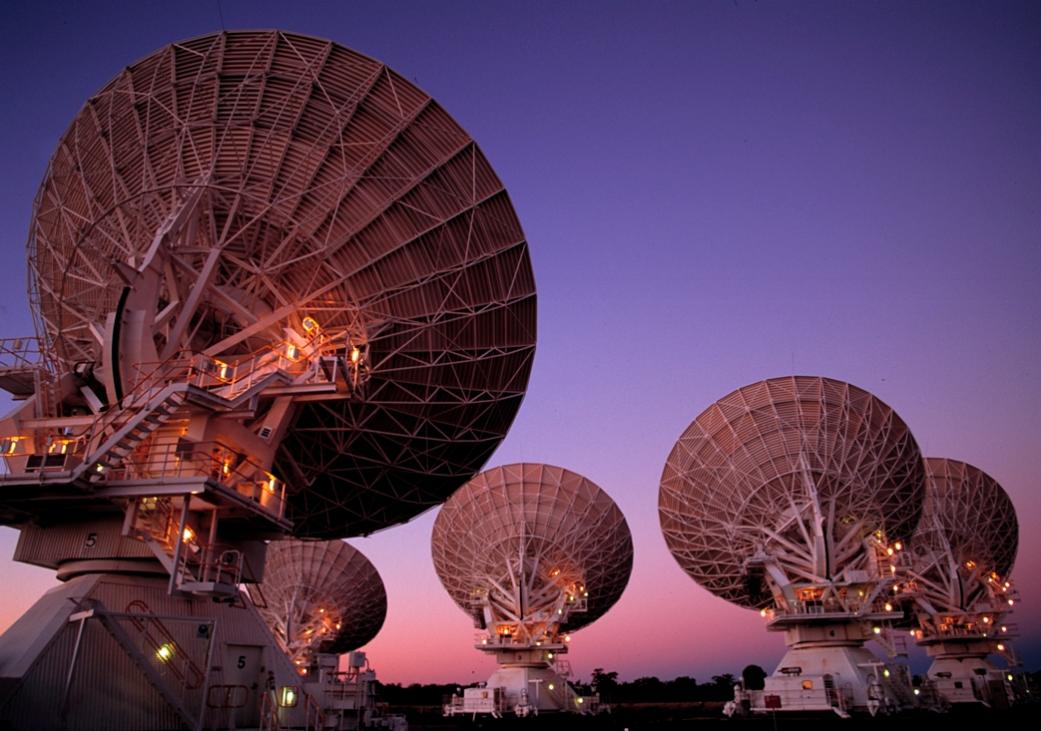
CSIRO’s Australia Telescope Compact Array radio telescope near Narrabri, NSW. Credit: David Smyth/CSIRO.
Gravitational Waves World-First Discovery Down Under
October 17, 2017: CSIRO - Partner media release from The University of Sydney.
An Australian group was the first in the world to confirm the radio emission from a gravitational wave event, discovered by collaborators in the United States being announced today.
The discovery of gravitational waves in 2015 was awarded the Nobel Prize for physics this year. The discovery of these ripples in space-time, produced by massive, accelerating bodies, like orbiting black holes (which cannot be seen directly) or neutron stars, confirms a prediction made by Albert Einstein in 1916.
Now, a group led by Associate Professor Tara Murphy, from the University of Sydney and the Centre of Excellence for All-Sky Astrophysics (CAASTRO), has confirmed radio-wave emission from a gravitational wave event discovered on 17 August this year.
The results are included in a Science paper published today with co-author institutions including the California Institute of Technology (Caltech) and Oxford University; simultaneously teams from the international science community are publishing related research in other leading journals, demonstrating the second epoch in gravitational waves discovery.
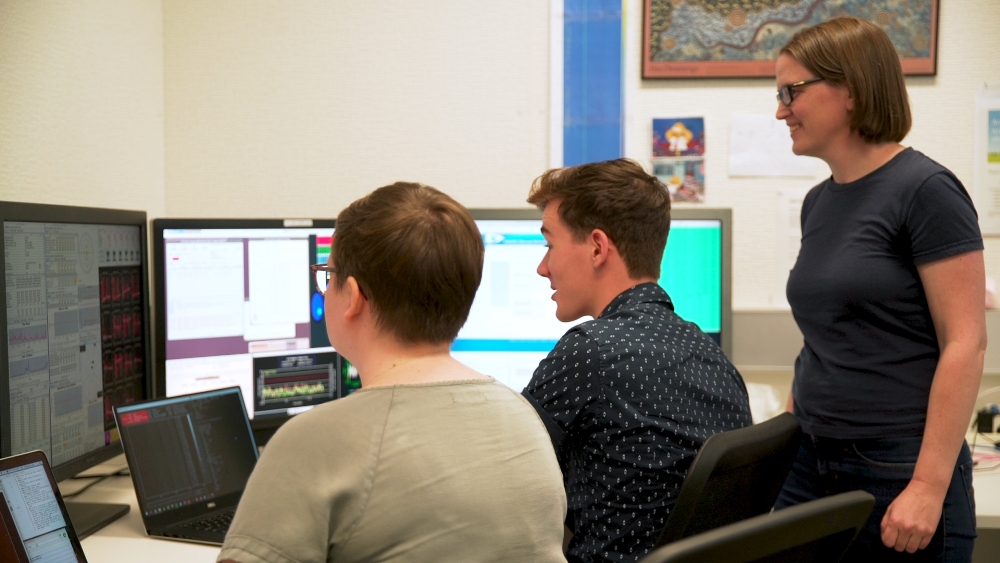
Prof Murphy standing with astronomer Christene Lynch and PhD student Dougal Dobie
Scientists representing LIGO-Virgo, and some 70 observatories today reveal the gravitational waves discovery – the first to produce light and radio waves, not just gravitational waves.
The explosion, produced by a pair of neutron stars merging, took place in galaxy NGC 4993, about 130 million light-years away. The first follow-up detection was optical, about 11 hours after the event, and was detected by a number of groups worldwide. X-ray emissions were detected nine days later and radiowaves after 15 days.
University of Sydney Associate Professor Tara Murphy, who leads the radio astronomy follow-up in Australia, said she was in the United States with colleague David Kaplan when they saw the gravitational wave announcement come through on the private email list of the Advanced Laser Interferometer Gravitational-Wave Observatory (LIGO).
“We immediately rang our team in Australia and told them to get onto the CSIRO telescope as soon as possible, then started planning our observations,” she said.
“We were lucky in a sense in that it was perfect timing but you have to be at the top of your game to play in this space. It is intense, time-critical science.”
PhD candidate Dougal Dobie spent hours observing on the telescope.
The team used the CSIRO's Australia Telescope Compact Array to monitor the gravitational wave event for more than 40 hours over several weeks. Dr Douglas Bock, Director of CSIRO’s Astronomy & Space Science team, said this extraordinary detection by an Australian team, using Australian facilities, made a significant contribution to the global discovery.
“Running a national facility involves providing researchers with access – fast – so they can monitor unexpected astronomical events of extraordinary scientific interest,” Dr Bock said.
The ARC Centre of Excellence for Gravitational Waves (OzGrav) director Professor Matthew Bailes said: “Never before have we seen where in the Universe gravitational waves came from; the subsequent avalanche of science was virtually unparalleled in modern astrophysics.”
University of Sydney Vice-Chancellor and Principal Dr Michael Spence said: “This international discovery, with Sydney playing an integral role, demonstrates that the best science and modern innovation is intrinsically a collaborative effort.
“What a terrific way to confirm that Einstein’s theory of relativity was correct, gain insights into massive bodies like black holes and, with this knowledge, start to re-think our understanding of the Universe,” Dr Spence concluded.
G. Hallinan, A. Corsi, K. P. Mooley, K. Hotokezaka, E. Nakar, M. M. Kasliwal, D. L. Kaplan, D. A. Frail, S. T. Myers, T. Murphy, K. De, D. Dobie, J. R. Allison, K. W. Bannister, V. Bhalerao, P. Chandra, T. E. Clarke, S. Giacintucci, A. Y. Q. Ho, A. Horesh, N. E. Kassim, S. R. Kulkarni, E. Lenc, F. J. Lockman, C. Lynch, D. Nichols, S. Nissanke, N. Palliyaguru, W. M. Peters, T. Piran, J. Rana, E. M. Sadler, L. P. Singer. A radio counterpart to a neutron star merger. Science, 2017 DOI: 10.1126/science.aap9855
Radio 'Eyes' Unlocking Secrets Of Neutron-Star Collision
October 16, 2017: National Radio Astronomy Observatory
When a pair of superdense neutron stars collided and potentially formed a black hole in a galaxy 130 million light-years from Earth, they unleashed not only a train of gravitational waves but also an ongoing torrent of radio waves that are answering some of the biggest questions about the nature of such a cataclysmic event.
On August 17, the LIGO and VIRGO gravitational-wave observatories combined to locate the source of faint ripples in spacetime caused by the merger of the two neutron stars. This was only the fourth direct detection of gravitational waves, which were predicted more than a century ago by Albert Einstein's General Theory of Relativity. In this case, for the first time, electromagnetic radiation -- light, gamma rays, and radio waves -- were detected coming from the same object that emitted the gravitational waves.
"The story that now is unfolding is more complete than for any previous event in astronomical history. With information provided by both gravitational waves and electromagnetic waves, which are completely different phenomena, it's like being able to both see and hear the same event for the first time," said Gregg Hallinan, of Caltech.
"The gravitational waves confirmed that we're seeing the merger of two neutron stars, and the radio waves we're observing are going to answer important questions about how much energy was in the explosion, how much mass was ejected, and what kind of environment this explosion occurred in," said Alessandra Corsi, of Texas Tech University.
Hallinan, Corsi and collaborators coordinated various radio telescopes across the globe to observe the galaxy in which the explosion, called GW170817, occurred just a day after the gravitational waves were detected. The first detection of radio waves came from the National Science Foundation's Karl G. Jansky Very Large Array (VLA) on September 2. This radio discovery was made by the Jansky VLA mapping of Gravitational Wave bursts as Afterglows in Radio (JAGWAR) team, where Hallinan played a key role. Independent confirmation came subsequently from a smaller team led by Corsi, also observing with the VLA. The Australia Telescope Compact Array (ATCA) also detected radio emission from the object on September 5.
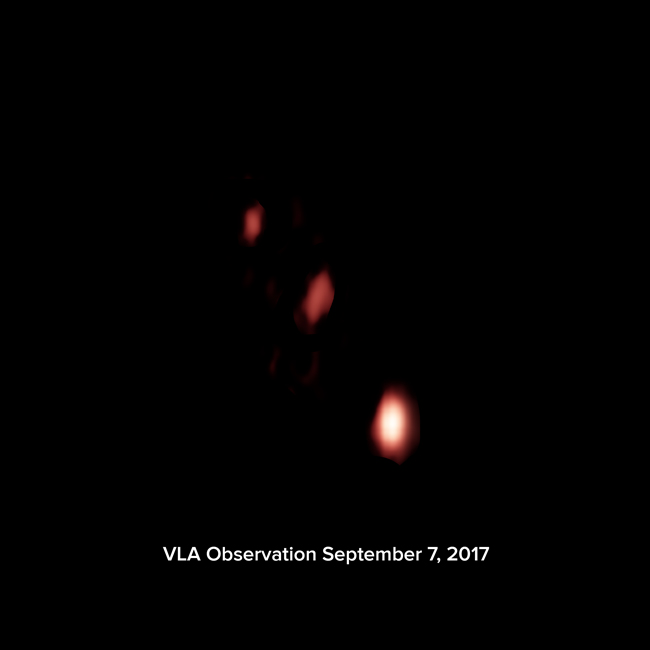
VLA image of the radio emissions coming from the location where two neutron stars collided and generated gravitational waves. The emission from the collision site is the middle object in this image. Credit: NRAO/AUI/NSF; G. Hallinan & A. Corsi et al., K. Mooley et al.
"This event is the first unambiguous detection of a merger of two neutron stars," said Dale Frail of the National Radio Astronomy Observatory (NRAO). "Such mergers are thought to be the cause of one type of Gamma Ray Burst, and we now have the opportunity to test the theories that have been proposed about how those bursts and their afterglows work," he added.
So far, the scientists said, the evidence provided by the radio observations indicates that the explosion either produced a jet of particles moving at nearly the speed of light that we are seeing at an angle widely separated from the jet's axis, or that there is a "cocoon" of material expanding more slowly from the explosion.
"The radio waves are still coming in, and will continue to do so for months or even years," Corsi said. "Their behavior over that time will tell us which story is correct."
In addition, the radio observations will tell the scientists how dense the environment around the explosion is, and into which the debris is expanding.
"Another exciting possibility is that if the radio emission is coming from a cocoon, we may be able to directly image it with high-resolution radio telescope systems using antennas separated by thousands of miles," said Kunal Mooley, of the University of Oxford in the UK, who is the principal investigator of the JAGWAR program. "We should know about this in just a few months."
"Radio telescopes now are our key to learning the physics of this explosion. The radio emission came late to the party, but it's the last to leave! We will continue to learn important facts about this event in the coming months," Hallinan said.
The object already has faded below the sensitivity limits of most ground-based telescopes except at radio wavelengths, where the VLA will continue to play a very important role.
"This event is our first look at the neutron-star collision process that creates heavy elements such as gold, which are included in the material moving outward from the explosion and producing the radio waves. That means that there is a little bit of neutron-star merger material in all of us," Mooley said.
Hallinan and Corsi's team reported their results in the journal Science.
Another team of VLA observers also detected radio emission from the event.
The National Radio Astronomy Observatory is a facility of the National Science Foundation, operated under cooperative agreement by Associated Universities, Inc.
M. M. Kasliwal, E. Nakar, L. P. Singer, D. L. Kaplan, D. O. Cook, A. Van Sistine, R. M. Lau, C. Fremling, O. Gottlieb, J. E. Jencson, S. M. Adams, U. Feindt, K. Hotokezaka, S. Ghosh, D. A. Perley, P.-C. Yu, T. Piran, J. R. Allison, G. C. Anupama, A. Balasubramanian, K. W Bannister, J. Bally, J. Barnes, S. Barway, E. Bellm, V. Bhalerao, D. Bhattacharya, N. Blagorodnova, J. S. Bloom, P. R. Brady, C. Cannella, D. Chatterjee, S. B. Cenko, B. E. Cobb, C. Copperwheat, A. Corsi, K. De, D. Dobie, S. W. K. Emery, P. A. Evans, O. D. Fox, D. A. Frail, C. Frohmaier, A. Goobar, G. Hallinan, F. Harrison, G. Helou, T. Hinderer, A. Y. Q. Ho, A. Horesh, W.-H. Ip, R. Itoh, D. Kasen, H. Kim, N. P. M. Kuin, T. Kupfer, C. Lynch, K. Madsen, P. A. Mazzali, A. A. Miller, K. Mooley, T. Murphy, C.-C. Ngeow, D. Nichols, S. Nissanke, P. Nugent, E. O. Ofek, H. Qi, R. M. Quimby, S. Rosswog, F. Rusu, E. M. Sadler, P. Schmidt, J. Sollerman, I. Steele, A. R. Williamson, Y. Xu, L. Yan, Y. Yatsu, C. Zhang, W. Zhao. Illuminating gravitational waves: A concordant picture of photons from a neutron star merger. Science, Oct 2017 DOI: 10.1126/science.aap9455
Australia And The United States Sign Historic Space Treaty
18 October 2017: Media Release - Senator the Hon Arthur Sinodinos AO, Minister for Industry, Innovation and Science
In Washington this morning the Turnbull Government signed a treaty with the National Aeronautics and Space Administration (NASA), reaffirming a commitment made by Australia and the United States of America more than 50 years ago to collaborate on space exploration.
Ambassador Joe Hockey signed the historic Space Tracking Treaty on behalf of Australia, with the Acting Administrator of NASA, Robert Lightfoot Jr, signing on behalf of the USA at a ceremony at the Australian Embassy in Washington D.C.
The Space Tracking Treaty covers civil space facilities owned by NASA and located within Australia, including the Canberra Deep Space Communication Complex (CDSCC) at Tidbinbilla, as well as facilities in Western Australia and the Northern Territory.
Acting Minister for Industry, Innovation and Science, Michaelia Cash, said Australia continued to play a major role in NASA's exploration of space.
“The signing of this treaty comes at a very important time in the development of the space industry in Australia given the Turnbull Government’s commitment to establish a national space agency,” Minister Cash said.
“Australia plays an integral part in space vehicle tracking having assisted in almost all of NASA’s human and robotic missions to space.”
“Our space collaboration with the United States of America began in 1957 with the establishment of a radio tracking facility in Woomera and was formalised in 1960 with the signing of a bi-lateral treaty on space vehicle tracking.”
“This treaty remains the foundation for a continued cooperative program between Australia and the United States.”
Mr Lightfoot said Australia’s contribution to NASA's exploration of space over the decades had been immense and the treaty signing would ensure this long and close relationship would continue.
CSIRO Chief Executive, Larry Marshall, said he was delighted with the signing of the treaty and the sharing of knowledge that will arise from this opportunity.
“For more than 50 years, CSIRO has been proud to be one of NASA’s homes in the Southern Hemisphere, leveraging our geography and sharing in the world-class capabilities of our scientists,” Mr Marshall said.
“From humanity’s first steps on the Moon, to flying past Pluto, to Cassini’s recent descent into Saturn, CSIRO and NASA have partnered to not only see more deeply into our Universe, but inspire the next generation of scientists.”
ANU Welcomes This Year’s Nobel Prize In Physics
3 October, 2017: Australian National University
ANU has welcomed this year's Nobel Prize in Physics for the ground-breaking work to detect gravitational waves for the first time, 100 years after their existence was predicted by Albert Einstein.
ANU Vice-Chancellor and Nobel Laureate Professor Brian Schmidt AC congratulated Professor Barry Barish, Professor Kip Thorne and Professor Rainer Weiss from the United States for winning the award on behalf of an international team in which ANU has played a key role.
"A triumph of physics. The discovery of gravitational waves has led to a new age of gravitational wave astronomy, allowing scientists to unlock many secrets of the Universe," said Professor Schmidt, who won the 2011 Nobel Prize in Physics.
"In future, this technique will probe the nature of black holes, neutron stars, supernovae and other things not yet imagined. We may be able to look back to almost the beginning of time - just after the big bang, which we cannot do with light. This is just the beginning, I cannot wait to see what they discover next.
"On behalf of ANU, I congratulate the winners, and ANU and Australian researchers who have helped make this amazing discovery possible."
The Nobel Prize for the first confirmed observation of a gravitational wave, ripples in space-time caused by the cataclysmic collision of two large black holes 1.3 billion years ago, was a landmark discovery that opened up new fields in physics and astrophysics.
Funded by the Australian Research Council (ARC) and led by ANU, Australia was one of the four partners in the Advanced Laser Interferometer Gravitational-Wave Observatory (LIGO) along with the United States, Germany and the United Kingdom.
"Thorne and Weiss were the founders and architects of LIGO - giants of the field - and Barish brought it to fruition. They are fitting winners of the Nobel Prize," Professor Schmidt said.
ANU supplied equipment and techniques that are used in the Advanced LIGO detectors.
The international team has made three more detections of gravitational waves since the first detection in September 2015.
The leader of the Australian Partnership in Advanced LIGO and Deputy Director of the ARC Centre of Excellence for Gravitational Wave Discovery is ANU Professor David McClelland.
"It is fitting and apt that this landmark achievement in the history of physics should be recognised with Nobel prizes for the founders of LIGO," said Professor McClelland from the ANU Research School of Physics and Engineering.
"ANU played an integral role in this amazing discovery, which has led to the award of this year's Nobel Prize in Physics. We are extremely proud to have played a part in this momentous event."
Professor Susan Scott, who is Leader of the General Relativity Theory and Data Analysis Group at ANU, said the 100-year journey of scientific discovery started with Einstein's miraculous theory of general relativity in 1915.
"Two of the greatest predictions from Einstein's general theory of relativity, black holes and gravitational waves, came together in this discovery," said Professor Scott from the ANU Research School of Physics and Engineering.
"Australia has been involved from the beginning 30 years ago in the quest to create the most sensitive instrument on Earth that was required to detect the minute distortions of space-time which we call gravitational waves."
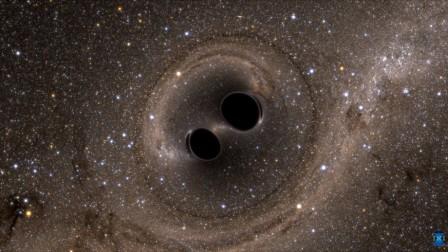
An artist's impression of two black holes merging. Image: SXS
Few Australians Know The Unique Role The Country Plays In The Global Space Network
By Dr Larry Marshall, Chief Executive 27 September 2017: CSIRO
In 1969, I sat on the floor of my classroom watching, spellbound, as Neil Armstrong took his first steps on the Moon. I never dreamt that a few decades later, I’d be one of the first to see images from Pluto as part of the critical role our team at the Canberra Deep Space Communication Complex plays in NASA’s New Horizons and Cassini missions.
How could a kid sitting in a classroom in Sydney, miles away from the rest of the world, believe Australia had such an important part to play in our exploration of space?
Today few schoolchildren — in fact, probably few adults as well — know the unique role Australia plays in the global space network. Australia is positioned perfectly to look up into the centre of the galaxy — something you can’t do from many other parts of the world. That outstanding location and our world-class capability in space science underpins a phenomenal contribution to international space programs.
Our partnership with NASA stretches back more than 50 years, grounded in our world-class infrastructure and scientists at Canberra and Parkes, and fuelled into the future by our shared ambition to push the boundaries of exploration to benefit life back on earth.
From November, we will control all NASA’s deep space assets worldwide for about a third of every day, using the ‘follow the sun’ protocol, as well as communicating with European and Indian spacecraft. It’s a rare day in our control centres when we don’t talk to partners on every part of the globe.
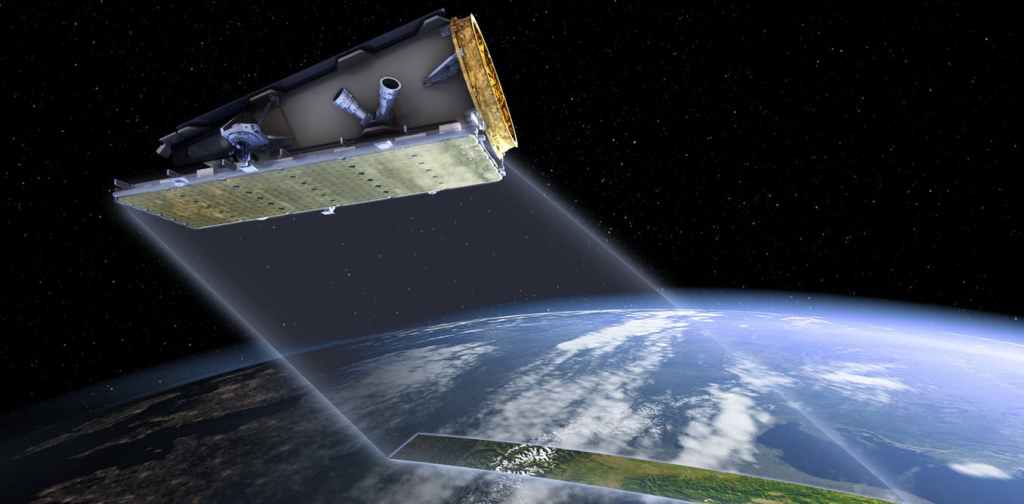
We lease time from NovaSAR satellite for images of SA bushfires, floods.
But beyond the beauty, the mystery, and the innate lure of the vast universe that surrounds us — what’s in it for Australia to invest in space?
For a start, if you’re reading this online, chances are you’re using WiFi, invented by CSIRO and using an algorithm we developed in radio astronomy work. But what about implications for the environment? On a daily basis, many dedicated people across our organisating deliver crucial insights through Earth observation. They work closely with more than a dozen international space organisations to turn big data into insights that solve challenges ranging from disaster prevention, bushfires, floods and spills, to biosecurity threats.
We partner with the European Space Agency (ESA) to access their international satellite data, and with NASA to monitor places from the Great Barrier Reef to the Great Australian Bight, to the Lake Eyre Basin to the Adelaide Hills.
And today, here in Adelaide, we were thrilled to announce CSIRO has purchased a 10 per cent share of the NovaSAR Earth observation satellite, giving Australian scientists first usage rights when it flies over Australia and Southeast Asia, strengthening our ability to understand our environment and prepare for our future, and for the first time, giving Australian scientists the ability to control an imaging satellite.
But you don’t have to be a space organisation to be part of our space team. We work with Australian businesses up and down the space supply chain who benefit economically. For example, our partnership with EMC, a small business based in Perth, is about to deliver the world’s first solar power solution suitable for a radioastronomy site at our Australian Square Kilometre Array Pathfinder (ASKAP) in Murchison, WA.
This same site will soon be the Australian home to the world’s largest telescope. The project has been a brilliant result for EMC, which grew from a workforce of 10 to over 100 during the project. They’re now positioned to take on global radio astronomy energy tenders — and beyond.
Building on our long, strong history of partnerships with international space organisations, we’re seeing more deeply into the Universe, in more detail into our own environment, and sharing the benefits across our economy.
So what’s next? Australian science created the coatings on every Boeing aircraft, and as we go to Mars don’t be surprised to see Aussie innovation along for the ride.We collaborate with every Australian research institution, with the nation’s space advantage driven by this network of brilliant minds, working collaboratively to deliver the best outcomes for our nation.
Our opportunity is as unlimited as space itself.
This article original appeared in the Adelaide Advertiser.